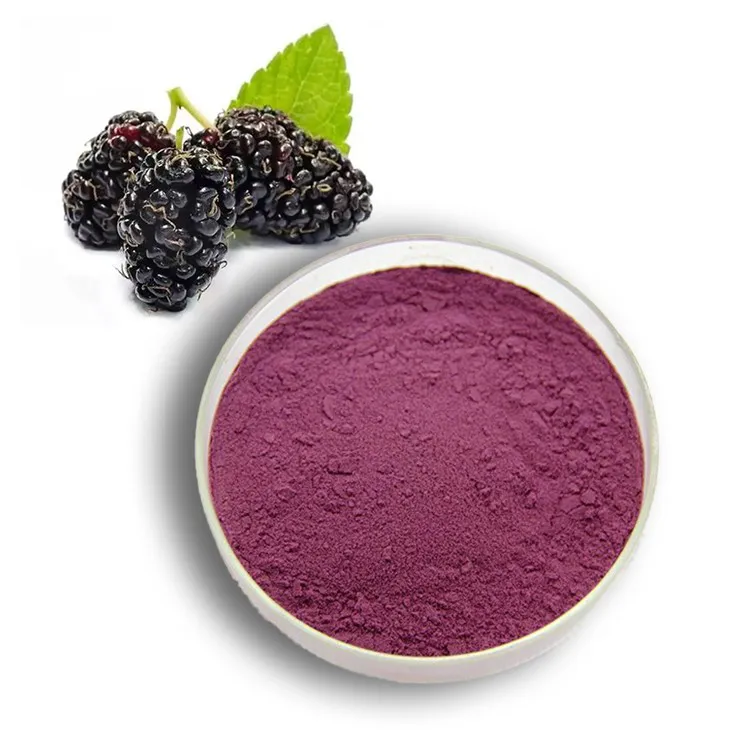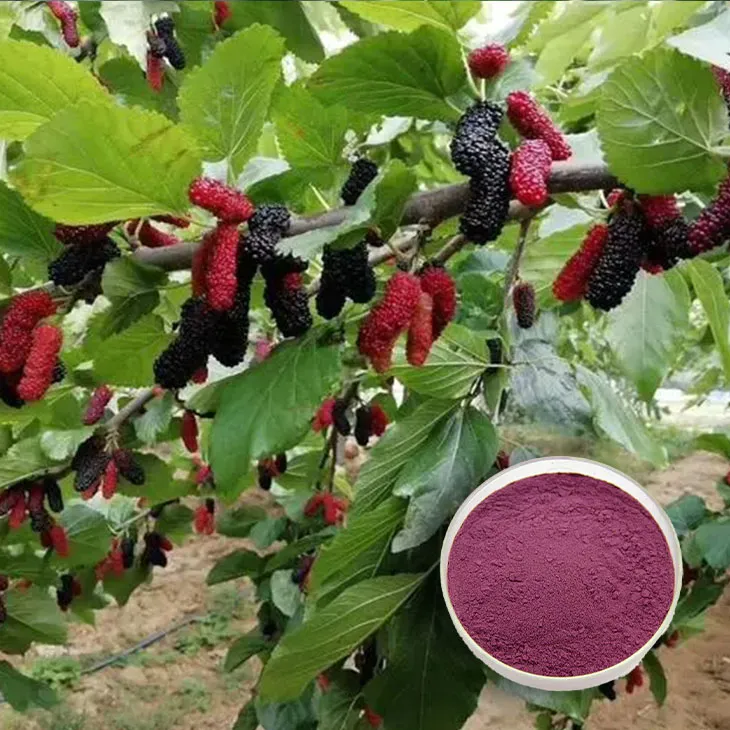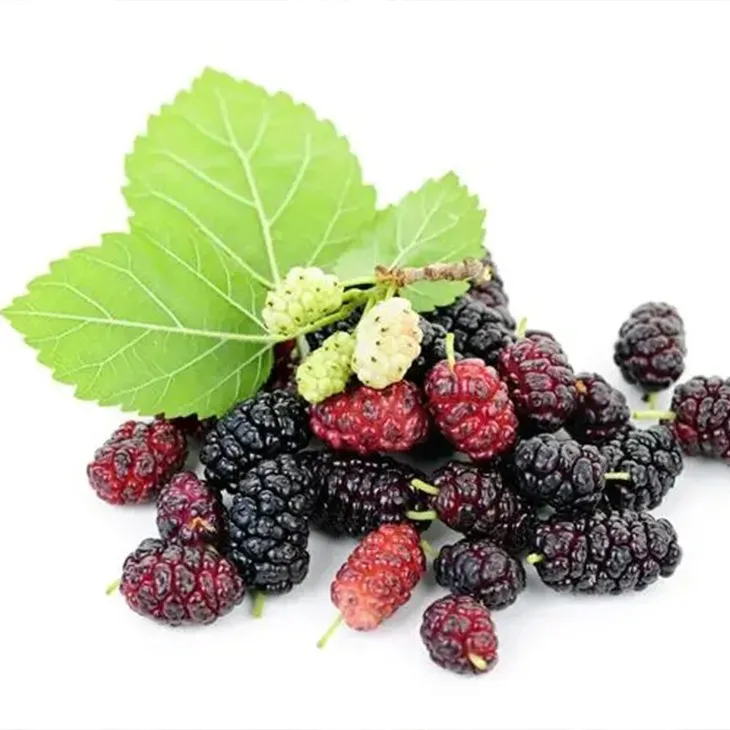- 0086-571-85302990
- sales@greenskybio.com
Components of Mulberry Extract in Fertilizers and Feeds.
2024-11-26

1. Introduction
Mulberry, a plant with a long history of cultivation, has been recognized for its multiple uses. Mulberry Extract, which is obtained from different parts of the mulberry plant such as leaves, branches, and fruits, contains a rich variety of substances. These substances endow Mulberry Extract with great potential in both fertilizers and feeds. In the field of agriculture, fertilizers play a crucial role in providing essential nutrients for plant growth. In animal husbandry, feeds are vital for the health and productivity of livestock. The exploration of Mulberry Extract in these two areas is of great significance for sustainable development.

2. Components of Mulberry Extract
2.1 Nutrients
Mulberry extract is rich in various nutrients. One of the most important nutrients is nitrogen (N). Nitrogen is a key element in plant growth as it is an essential component of proteins, nucleic acids, and chlorophyll. In fertilizers, the nitrogen in mulberry extract can be slowly released, providing a continuous source of nutrition for plants. In addition, mulberry extract also contains phosphorus (P) and potassium (K). Phosphorus is involved in energy transfer and storage in plants, while potassium helps regulate plant water balance and improves stress tolerance.
2.2 Organic Compounds
There are a variety of organic compounds in mulberry extract. Carbohydrates are present in significant amounts. These carbohydrates can be decomposed by soil microorganisms in fertilizers, releasing energy and promoting the growth of beneficial soil bacteria. In feeds, they can also provide energy for livestock. Another important group of organic compounds is amino acids. Amino acids are the building blocks of proteins. The presence of different amino acids in mulberry extract can improve the nutritional value of feeds for livestock. Some amino acids, such as lysine and methionine, are essential for livestock growth but may be deficient in regular feed ingredients.
2.3 Bioactive Substances
Mulberry extract is also rich in bioactive substances. Polyphenols are one of the main bioactive substances. They have antioxidant properties, which can protect plants from oxidative stress in fertilizers. In feeds, polyphenols can also have positive effects on the health of livestock by reducing inflammation. Another bioactive substance is flavonoids. Flavonoids can enhance the immune system of plants and animals. In addition, there are alkaloids in mulberry extract, which may have certain physiological regulatory functions in both plants and livestock.

3. Applications of Mulberry Extract in Fertilizers
3.1 Improving Soil Fertility
When added to fertilizers, mulberry extract can significantly improve soil fertility. The nutrients in mulberry extract can replenish the soil nutrient pool. For example, the nitrogen, phosphorus, and potassium in it can make up for the deficiencies of these elements in the soil. Moreover, the organic compounds in mulberry extract can improve soil structure. The carbohydrates and other organic substances can be decomposed by soil organisms, increasing soil porosity and water - holding capacity. This is beneficial for the growth of plant roots and the absorption of nutrients.
3.2 Promoting Plant Growth
Mulberry extract can directly promote plant growth. The nutrients it provides are essential for plant development at different stages. For young plants, the nitrogen in mulberry extract can promote leaf growth and chlorophyll synthesis. For flowering plants, phosphorus can enhance flower bud formation and flowering. Potassium can improve the quality of fruits and seeds. In addition, the bioactive substances in mulberry extract can enhance plant resistance to diseases and pests. The antioxidant properties of polyphenols can help plants resist oxidative damage caused by pathogens, and flavonoids can strengthen the plant's immune system.

4. Applications of Mulberry Extract in Feeds
4.1 Enhancing Nutritional Value
In feeds, mulberry extract can enhance the nutritional value. As mentioned before, the amino acids in it can supplement the essential amino acids in livestock feed. This is especially important for high - yielding livestock, such as dairy cows and broiler chickens, which have high requirements for protein quality. The carbohydrates in mulberry extract can also provide additional energy sources for livestock. In addition, the presence of some micronutrients in mulberry extract, such as vitamins and minerals, can further improve the nutritional balance of feeds.
4.2 Improving Livestock Health
Mulberry extract has positive effects on livestock health. The bioactive substances in it play an important role. For example, polyphenols can reduce inflammation in livestock bodies. This is beneficial for preventing and treating some inflammatory diseases in livestock. Flavonoids can enhance the immune system of livestock, making them more resistant to diseases. Alkaloids may also have certain regulatory functions on the physiological state of livestock, such as improving digestion and metabolism.
5. Challenges and Future Prospects
5.1 Challenges
Although mulberry extract has great potential in fertilizers and feeds, there are also some challenges. One of the challenges is the extraction and purification process. The extraction methods need to be further optimized to ensure high - quality and high - yield extraction of useful components from mulberry. Another challenge is the standardization of products. At present, there is no unified standard for mulberry extract - based fertilizers and feeds, which may lead to differences in product quality. In addition, the cost of production also needs to be considered. The production cost of mulberry extract - based products may be relatively high, which may limit their large - scale application.
5.2 Future Prospects
Despite the challenges, the future prospects of mulberry extract in fertilizers and feeds are still very promising. With the continuous development of extraction technology, it is expected that more efficient and cost - effective extraction methods will be developed. The standardization of products will also be gradually improved with the attention of relevant departments and industries. In addition, as people pay more attention to sustainable development and environmental protection, mulberry extract, as a natural and environmentally friendly product, will be more widely recognized and applied. For example, in organic farming, mulberry extract - based fertilizers can be used to replace some chemical fertilizers, reducing environmental pollution. In the field of animal husbandry, mulberry extract - based feeds can be used to produce high - quality and healthy livestock products.
FAQ:
What are the main components of mulberry extract?
Mulberry extract contains various components. It has nutrients like vitamins (such as vitamin C, vitamin E), minerals (such as potassium, calcium), and amino acids. Additionally, it also contains bioactive substances like flavonoids, polyphenols which are beneficial for different applications.
How does mulberry extract enhance soil fertility in fertilizers?
The nutrients in mulberry extract, such as minerals, can be released into the soil. The bioactive substances may also interact with soil microorganisms. For example, flavonoids can stimulate the growth of certain beneficial bacteria in the soil, which in turn can improve soil structure and nutrient availability, thus enhancing soil fertility.
What health benefits does mulberry extract offer to livestock in feeds?
Mulberry extract can improve the antioxidant capacity of livestock due to its flavonoids and polyphenols content. It may also enhance the immune system of the animals. Moreover, the amino acids in it can contribute to better growth and development of livestock.
Are there any potential drawbacks of using mulberry extract in fertilizers and feeds?
One potential drawback in fertilizers could be improper dosage leading to nutrient imbalance in the soil. In feeds, if not properly processed, there might be issues such as indigestion in livestock. Also, the cost of extraction and purification of mulberry extract might be relatively high, which could affect its widespread use.
How can mulberry extract be effectively incorporated into fertilizers and feeds?
For fertilizers, it can be formulated as a liquid or solid additive. In liquid fertilizers, it can be dissolved and mixed evenly. For solid fertilizers, it can be granulated together with other components. In feeds, it can be mixed with other feed ingredients in appropriate proportions. Processing techniques like drying and pulverizing might be used to ensure uniform distribution in the feed.
Related literature
- The Role of Mulberry Extract in Agricultural Fertilization"
- "Mulberry Extract: A Promising Feed Additive for Livestock Health"
- "Components of Mulberry and Their Applications in Fertilizer and Feed Industries"
- ▶ Hesperidin
- ▶ citrus bioflavonoids
- ▶ plant extract
- ▶ lycopene
- ▶ Diosmin
- ▶ Grape seed extract
- ▶ Sea buckthorn Juice Powder
- ▶ Beetroot powder
- ▶ Hops Extract
- ▶ Artichoke Extract
- ▶ Reishi mushroom extract
- ▶ Astaxanthin
- ▶ Green Tea Extract
- ▶ Curcumin Extract
- ▶ Horse Chestnut Extract
- ▶ Other Problems
- ▶ Boswellia Serrata Extract
- ▶ Resveratrol Extract
- ▶ Marigold Extract
- ▶ Grape Leaf Extract
- ▶ blog3
- ▶ blog4
-
Chinese Withania somnifera Extract Factory.
2024-11-26
-
中国松树皮提取物粉粉末供应商
2024-11-26
-
High - quality Marigold Extract Products.
2024-11-26
-
100% Pure Natural Mango - Flavored Powder.
2024-11-26
-
Curcumin
2024-11-26
-
Lycopene
2024-11-26
-
Artichoke Leaf Extract
2024-11-26
-
Marigold Extract
2024-11-26
-
Feverfew Extract
2024-11-26
-
Phyllanthus Emblica Extract
2024-11-26
-
Bayberry Extract
2024-11-26
-
Avocado Extract Powder
2024-11-26
-
Ginger Extract
2024-11-26
-
Cat Claw Extract
2024-11-26





















